We all love to talk about our Favorite Things, but it’s not always the latest and greatest that charms us. Sometimes it’s those foundational favorites, the works that shaped us, that we find ourselves returning to again and again. Here at Speculative Chic, we decided it was way past time to create a dedicated platform to shine a spotlight on these longtime gems. Welcome to Blast from the Past.
Today we bring you horror author Matt Betts, whose latest book, White Anvil: Sasquatch Onslaught, came out last fall from Severed Press, and whose Carson of Venus: The Edge of All Worlds, is forthcoming from American Mythology Productions.
Dan Stout, author of Titanshade, said of White Anvil,
“For those of us who grew up on Saturday morning creature features and painstakingly tuned-in to horror hosts using our dented and bent rabbit-ear antennas, Matt Betts delivers all the goods and more. White Anvil is packed with the excitement and atmosphere, but it also has what so many stories lack: Believable characters behaving rationally as they do their best to survive in the face of unexpected terror.”
What shaped Matt into the writing monsters amidst action and adventure? Based on the above blurb, I don’t think you’ll be surprised…
Horror Kindergarten: Everything I Learned from those Meddling Kids
When people write an article like this they tend to talk about the giants of literature that influenced them, the films that terrified them as a kid, or the importance of a particular album on their youth. I feel a bit sheepish then in presenting what I consider the defining piece of pop culture on my life. It isn’t high art. It isn’t a classic novel.
 It’s Scooby-Doo.
It’s Scooby-Doo.
Scooby-Doo was an element of my childhood which sticks with me to this day, and it taught me some crucial elements of storytelling.
And I’m not talking about the live-action movies with Sarah Michelle Gellar, Matthew Lillard, and Freddie Prinze Jr. from 2002 and 2004. And I’m certainly not talking about The New Scooby and Scrappy Show that aired in the early eighties. Scrappy is dead to me. Seriously, don’t even mention his name. This is Scooby-Doo, Where Are You! the cartoon series that started in 1969 and ran for a couple of seasons and then repeated for decades. To some extent the Scooby-Doo movies that followed a couple of years later were more of the same style of storytelling, just with the added bonus of guest stars thrown in, like Batman, The Harlem Globetrotters, Don Knotts, Jonathan Winters, and Davy Jones. (Those references alone make me feel incredibly old.)
I know it sounds silly to proclaim my undying love for a cartoon, or the importance it had on my evolution as a writer, but I stand by it. Back in my day (when we walked to school uphill in the snow, and dinosaurs roamed the plains) we didn’t have a whole lot of television channels to choose from. I was stuck with whatever programming I could find for kids, and Scooby-Doo just happened to air every day after school, and on Saturday mornings. They ran those few episodes from what amounted to three or four seasons over and over. And over.

It took me years to really figure it out, but the first story I wrote and illustrated was an accidental Scooby-Doo rip off. It involved some kids exploring a haunted mansion and being attacked by a suit of haunted armor. Seriously, it took me years to see the Scooby-Doo influence on it. It was, in hindsight, awful. But it was the first story that I wrote with a beginning, middle and end. It had a plot, such as it was, and an attempt at characters. It was a start.
One of my friends once pointed out to me what he considered the brilliance of Scooby-Doo cartoons: It is a show you didn’t have to actually see to understand exactly what is happening. As long as you could hear it, you knew what was happening. The dialogue reinforced every action.
“Look! Over there! What’s that stuck in the floor?”
“It’s a note.”
“Like, what’s it say?”
“It says “Beware of the Ghostly Pirate.”
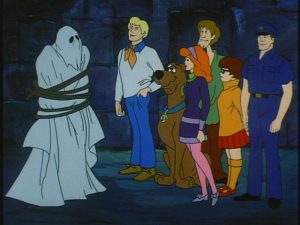 As writers, we’re always told “Show, don’t tell” when fleshing out our work, Scooby-Doo was the exact opposite of that advice. It was “Show AND tell. And then maybe even tell again.” Yes, it was made for kids and was styled to make sure that those viewers didn’t miss a clue. But for me, it was terrific instruction in story beats and plotting. Show AND tell is a terrific piece of writing advice. Not that authors need to blatantly do both every time, but that dialogue, setting, and description need to be balanced. They all have a place in a story, and each has a job to do.
As writers, we’re always told “Show, don’t tell” when fleshing out our work, Scooby-Doo was the exact opposite of that advice. It was “Show AND tell. And then maybe even tell again.” Yes, it was made for kids and was styled to make sure that those viewers didn’t miss a clue. But for me, it was terrific instruction in story beats and plotting. Show AND tell is a terrific piece of writing advice. Not that authors need to blatantly do both every time, but that dialogue, setting, and description need to be balanced. They all have a place in a story, and each has a job to do.
Scooby-Doo, Where Are You! was a series that was stuck in time, where the characters never grew and we never learned much about them. Later series talked about their past and their families, and even made references to their other adventures, but those first seasons painted the characters in broad strokes and left them at that. Where were they from? How could they afford to drive around the country, busting ghosts? Did they own any other clothing? How could they afford all those sandwiches and Scooby Snacks? Who knows? Each character had their own quirks that set them apart from the others. And that was enough. Backstory? Nah. Velma was smart (we knew that mainly because she wore glasses), Scooby and Shaggy were cowardly and perpetually hungry, Daphne was somewhat of a socialite, and Freddy was strong and sort of brave, I suppose. While creating characters as stereotypes isn’t an effective way to create a novel, the characters of Scooby-Doo showed how important it was to find a way to differentiate one character from another. A reader wouldn’t see characters like a movie or cartoon, they only have the author’s words to imagine who each player in the story is.
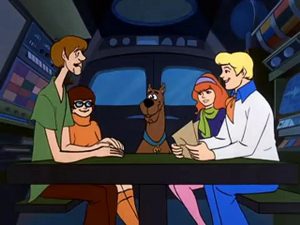 Finally, Scooby-Doo was my introduction to anything and everything even the least bit frightening — tropes and creatures that I would eventually revisit in my own work. Zombies, witches, snow beasts, phantoms. Haunted houses, ghost ships, amusement parks and dark, musty caves. As a kid, these things were all pretty scary, except when paired with a talking dog. The show was a gateway to everything from The X-Files to Buffy the Vampire Slayer. When I first started watching real horror movies, I always tried to compare the movie monster to a creature in Saturday morning cartoons, and sometimes that made them just a little less scary. A little. Let’s face it though, each episode of Scooby-Doo ended with someone pulling a mask off a monster and proving it was just a fake and nobody was in any real danger, while in actual horror movies, the ending sometimes featured someone’s head literally being pulled off. Scooby-Doo couldn’t prepare me for everything, I guess.
Finally, Scooby-Doo was my introduction to anything and everything even the least bit frightening — tropes and creatures that I would eventually revisit in my own work. Zombies, witches, snow beasts, phantoms. Haunted houses, ghost ships, amusement parks and dark, musty caves. As a kid, these things were all pretty scary, except when paired with a talking dog. The show was a gateway to everything from The X-Files to Buffy the Vampire Slayer. When I first started watching real horror movies, I always tried to compare the movie monster to a creature in Saturday morning cartoons, and sometimes that made them just a little less scary. A little. Let’s face it though, each episode of Scooby-Doo ended with someone pulling a mask off a monster and proving it was just a fake and nobody was in any real danger, while in actual horror movies, the ending sometimes featured someone’s head literally being pulled off. Scooby-Doo couldn’t prepare me for everything, I guess.
 Matt Betts worked for years in radio as an on-air personality, anchor and reporter. His fiction and poetry have appeared in numerous journals and anthologies. His work includes the steampunk novel, Odd Men Out, urban fantasy book Indelible Ink, and his most recent release, White Anvil: Sasquatch Onslaught. Matt’s upcoming 2020 release Carson of Venus: The Edge of all Worlds continues a series begun by Edgar Rice Burroughs.
Matt Betts worked for years in radio as an on-air personality, anchor and reporter. His fiction and poetry have appeared in numerous journals and anthologies. His work includes the steampunk novel, Odd Men Out, urban fantasy book Indelible Ink, and his most recent release, White Anvil: Sasquatch Onslaught. Matt’s upcoming 2020 release Carson of Venus: The Edge of all Worlds continues a series begun by Edgar Rice Burroughs.
White Anvil || Carson of Venus || Website || Twitter || Facebook
Author Photo by Catherine Murray
Want to share the formative favorites shaped YOU into the writer you are today? Check out our guidelines and fill out the form here.

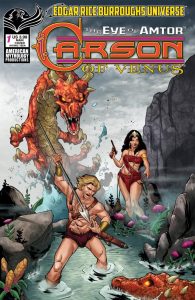
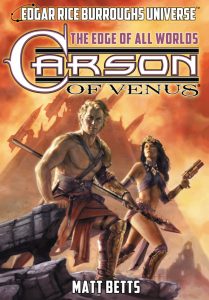
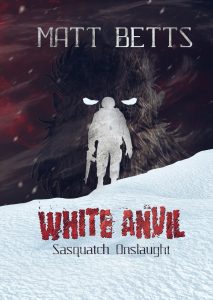
So many hours of my life were spent watching Scooby Doo. I blame it for my love for urban fantasy.
When I was in college, the Cartoon Network was one of the channels I would most often have on (the other being Animal Planet), and Scooby Doo was a solid favorite.
My brother was a huge Scooby Doo fan and I feel like I probably saw every episode. Have you read Meddling Kids by Edgar Cantero? It’s basically Scooby Doo fan fiction. I avoided the book at first because it sounded silly but Cantero really pulls it off. It’s nostalgic fun but it also packs an unexpectedly emotional punch.
I haven’t read Meddling Kids yet! It’s on my list to buy. I’d love to check it out!